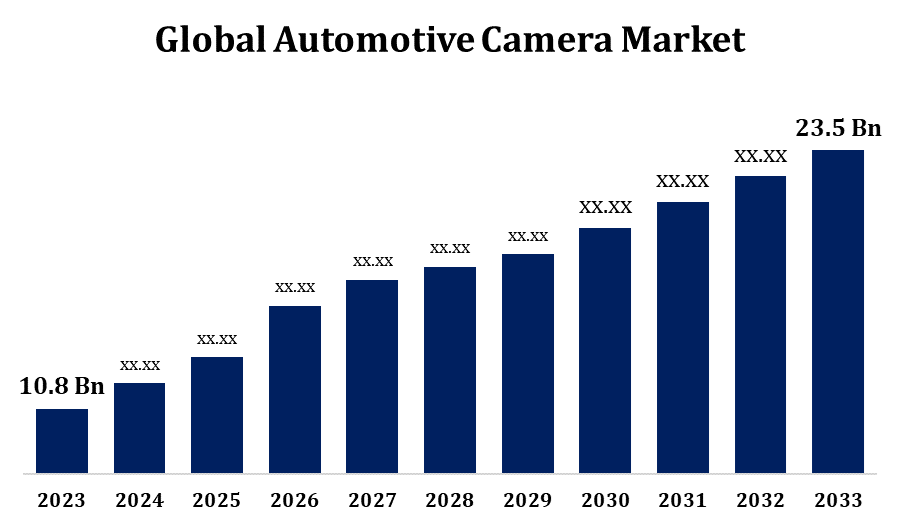Global Automotive Camera Market Size To Worth USD 23.5 Billion By 2033 | CAGR of 8.08%
Category: Automotive & TransportationGlobal Automotive Camera Market Size To Worth USD 23.5 Billion By 2033
According to a research report published by Spherical Insights & Consulting, the Global Automotive Camera Market Size to Grow from USD 10.8 Billion in 2023 to USD 23.5 Billion by 2033, at a Compound Annual Growth Rate (CAGR) of 8.08% during the Forecast period.

Get more details on this report -
Browse key industry insights spread across 240 pages with 110 Market data tables and figures & charts from the report on the "Global Automotive Camera Market Size, Share, and COVID-19 Impact Analysis, By Type (Stereo and Monocular), By Application Type (Park Assist System, Lane Departure Warning System, Blind Spot Detection, Lane Keep Assist, Road Sign Assistance, Adaptive Cruise Control (ACC), Intelligent Headlight Control, and Others), By Technology Type (Digital Camera, Infrared Camera, and Thermal Camera), By Vehicle Type (Passenger Cars and Commercial Vehicles), and By Region (North America, Europe, Asia-Pacific, Latin America, Middle East, and Africa), Analysis and Forecast 2023 - 2033." Get Detailed Report Description Here: https://www.sphericalinsights.com/reports/automotive-camera-market
The automotive camera market is growing rapidly, driven by the increasing demand for advanced driver-assistance systems (ADAS) and autonomous driving technologies. These cameras enhance vehicle safety by supporting features such as lane departure warning, adaptive cruise control, and collision avoidance. Stricter government safety regulations and the rising adoption of electric vehicles further propel market expansion. Leading companies are investing in high-resolution imaging, night vision, and AI-powered camera systems to enhance performance. The market is categorized by technology (thermal, infrared, digital), vehicle type (passenger and commercial), and application (ADAS, parking assistance, blind-spot detection). Asia-Pacific dominates the market due to high vehicle production, followed by North America and Europe. With continuous advancements and AI integration, the automotive camera market is set for significant growth in the coming years.
Automotive Camera Market Value Chain Analysis
The automotive camera market value chain consists of multiple stages, from raw material suppliers to end users. It starts with component manufacturers producing key elements such as lenses, image sensors, and processors. Camera module manufacturers then assemble these components, integrating advanced features like AI-driven image processing and thermal imaging. Tier-1 suppliers work closely with automakers to incorporate cameras into advanced driver-assistance systems (ADAS) and autonomous vehicles. Original Equipment Manufacturers (OEMs) integrate these systems into vehicles while ensuring compliance with safety regulations. The market operates through various distribution channels, including direct sales, aftermarket suppliers, and retailers. Additionally, software developers enhance camera capabilities with AI, computer vision, and data analytics. Growing demand for smart vehicles and stringent safety regulations continue to drive innovation and market expansion.
Automotive Camera Market Opportunity Analysis
The automotive camera market offers substantial growth opportunities, driven by advancements in autonomous driving, increasing adoption of ADAS, and stringent safety regulations. The rising demand for electric and connected vehicles further accelerates market expansion. Innovations in AI-powered imaging, 360-degree surround-view cameras, and thermal vision are creating new revenue streams. Emerging markets in Asia-Pacific and Latin America present lucrative prospects due to rising vehicle production and growing safety awareness. The aftermarket segment is also expanding as consumers upgrade vehicles with advanced safety features. Additionally, collaborations between automakers, tech companies, and sensor manufacturers are driving innovation. The integration of automotive cameras with LiDAR and radar for Level 3+ autonomous driving unlocks further possibilities. With the growing focus on smart mobility, the automotive camera market is set for long-term growth.
The growing adoption of 360-degree cameras is a major driver of the automotive camera market. These cameras offer a complete view of a vehicle’s surroundings, improving both safety and driver convenience. They are widely integrated into advanced driver-assistance systems (ADAS) for functions such as parking assistance, blind-spot monitoring, and collision prevention. Automakers are increasingly incorporating 360-degree camera systems to comply with stringent safety regulations and enhance user experience. The rising demand for autonomous and connected vehicles further fuels their adoption. Additionally, advancements in AI-powered image processing and high-resolution imaging continue to improve their functionality. With increasing consumer awareness and a strong focus on road safety, the use of 360-degree cameras is expected to grow, playing a crucial role in the expansion of the automotive camera market.
High production and integration costs limit widespread adoption, especially in budget and mid-range vehicles. Technical challenges, such as reduced performance in extreme weather or low-light conditions, impact reliability. Data security and privacy concerns also pose risks, as connected vehicle cameras collect and transmit sensitive information. Additionally, varying regulations across regions create compliance challenges for manufacturers. The complexity of integrating cameras with other sensors, including LiDAR and radar, increases development costs and time. The ongoing semiconductor shortage further disrupts supply chains, causing production delays. Furthermore, consumer hesitation toward fully autonomous technology slows adoption rates.
Insights by Application Type
The park assist system segment accounted for the largest market share over the forecast period 2023 to 2033. Advanced parking systems utilize multiple cameras, including 360-degree and rearview cameras, to deliver real-time visuals and automated assistance. Increasing urbanization and congested parking areas have intensified the demand for efficient parking solutions, driving wider adoption. Automakers are incorporating AI-powered image processing and ultrasonic sensors to improve accuracy and automation. Additionally, stringent safety regulations requiring rearview cameras in vehicles further boost market growth. The rising adoption of electric and autonomous vehicles also accelerates demand for advanced parking technologies. As consumers prioritize smarter and safer driving experiences, the park assist system segment is expected to maintain strong growth in the automotive camera market.
Insights by Type
The stereo segment accounted for the largest market share over the forecast period 2023 to 2033. Stereo cameras, equipped with dual-lens technology, precisely measure distances, making them crucial for advanced driver-assistance systems (ADAS) such as automatic emergency braking, lane-keeping assistance, and pedestrian detection. Automakers are increasingly integrating stereo cameras to enhance vehicle safety and comply with stringent regulations. The rising demand for autonomous and semi-autonomous vehicles further drives this segment’s growth, as stereo cameras enhance object detection and environmental mapping. Additionally, advancements in AI-powered image processing improve their performance in low-light and challenging weather conditions. With their growing adoption in both passenger and commercial vehicles, the stereo camera segment is set for sustained expansion in the automotive camera market.
Insights by Technology Type
The digital segment accounted for the largest market share over the forecast period 2023 to 2033. The growth is driven by high-resolution imaging, real-time processing, and seamless integration with advanced driver-assistance systems (ADAS). Unlike analog cameras, digital cameras provide superior image clarity, improving features such as lane departure warning, blind-spot detection, and adaptive cruise control. Automakers are increasingly adopting digital cameras to enhance vehicle safety and comply with evolving regulatory standards. The transition to electric and autonomous vehicles further boosts demand, as digital cameras play a key role in sensor fusion with LiDAR and radar systems. Additionally, advancements in AI-powered image processing and night vision capabilities enhance their performance across various driving conditions.
Insights by Vehicle Type
The passenger cars segment accounted for the largest market share over the forecast period 2023 to 2033. Automakers are incorporating cameras into applications like adaptive cruise control, lane departure warning, blind-spot detection, and park assist to improve vehicle safety and convenience. Stringent government regulations requiring rearview cameras and the adoption of ADAS further fuel market growth. Additionally, the increasing popularity of electric and autonomous vehicles heightens the demand for high-resolution and AI-powered cameras. As consumers place greater emphasis on safety and automation, there is a growing demand for camera-based systems in both mid-range and luxury passenger vehicles. With ongoing technological advancements and regulatory support, the passenger car segment is expected to drive substantial growth in the automotive camera market.
Insights by Region

Get more details on this report -
North America is anticipated to dominate the Automotive Camera Market from 2023 to 2033. Strict government regulations, such as the National Highway Traffic Safety Administration (NHTSA) requirements for rearview cameras, drive widespread adoption. The region’s robust presence of major automakers and tech companies promotes innovation in AI-powered imaging, thermal vision, and 360-degree camera systems. Increasing consumer demand for advanced safety features in passenger vehicles further accelerates market growth. Additionally, the expanding electric vehicle (EV) market and the push for Level 3+ autonomous vehicles are driving greater integration of camera systems.
Asia Pacific is witnessing the fastest market growth between 2023 to 2033. China, Japan, South Korea, and India are at the forefront of the market, driven by their strong automotive manufacturing industries and government regulations on vehicle safety. The rapid growth of electric vehicles (EVs) and autonomous driving technologies further fuels the demand for high-resolution and AI-powered cameras. Increasing urbanization and rising disposable incomes have led to higher consumer demand for safety and convenience features in vehicles. With ongoing technological advancements and growing investments in smart mobility, the Asia-Pacific region is poised to lead the global automotive camera market in the coming years.
Recent Market Developments
- In February 2024, VIA Optronics AG has signed a design and development partnership with Immervision Inc. to develop VIA's next-generation automotive camera.
Major players in the market
- Bosch
- Mobileye
- Continental
- Sharp
- Renesas Electronics
- LG Innotek
- STMicroelectronics
- Texas Instruments
- Cypress Semiconductor
- Aptiv
- Omnivision Technologies
- Valeo
- Nvidia
- Sony
Market Segmentation
This study forecasts revenue at global, regional, and country levels from 2023 to 2033.
Automotive Camera Market, Type Analysis
- Stereo
- Monocular
Automotive Camera Market, Application Type Analysis
- Park Assist System
- Lane Departure Warning System
- Blind Spot Detection
- Lane Keep Assist
- Road Sign Assistance
- Adaptive Cruise Control (ACC)
- Intelligent Headlight Control
- Others
Automotive Camera Market, Technology Type Analysis
- Digital Camera
- Infrared Camera
- Thermal Camera
Automotive Camera Market, Vehicle Type Analysis
- Passenger Cars
- Commercial Vehicles
Automotive Camera Market, Regional Analysis
- North America
- US
- Canada
- Mexico
- Europe
- Germany
- Uk
- France
- Italy
- Spain
- Russia
- Rest of Europe
- Asia Pacific
- China
- Japan
- India
- South Korea
- Australia
- Rest of Asia Pacific
- South America
- Brazil
- Argentina
- Rest of South America
- Middle East & Africa
- UAE
- Saudi Arabia
- Qatar
- South Africa
- Rest of the Middle East & Africa
About the Spherical Insights & Consulting
Spherical Insights & Consulting is a market research and consulting firm which provides actionable market research study, quantitative forecasting and trends analysis provides forward-looking insight especially designed for decision makers and aids ROI.
Which is catering to different industry such as financial sectors, industrial sectors, government organizations, universities, non-profits and corporations. The company's mission is to work with businesses to achieve business objectives and maintain strategic improvements.
CONTACT US:
For More Information on Your Target Market, Please Contact Us Below:
Phone: +1 303 800 4326 (the U.S.)
Phone: +91 90289 24100 (APAC)
Email: inquiry@sphericalinsights.com, sales@sphericalinsights.com
Contact Us: https://www.sphericalinsights.com/contact-us
Need help to buy this report?